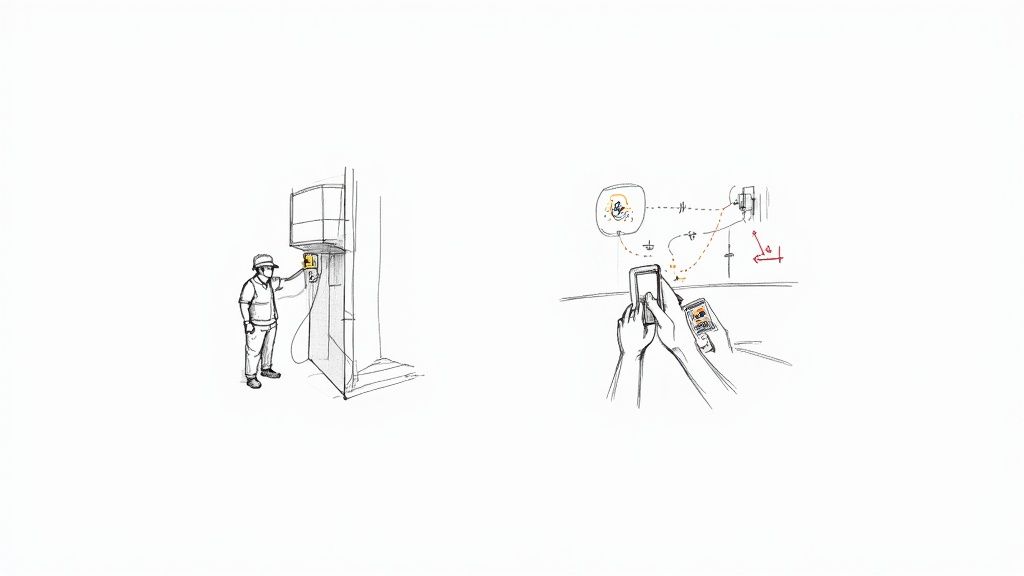wireless vs wired security systems: A Definitive Guide
When you're comparing wireless vs. wired security systems, the core of the debate really comes down to a trade-off: do you want permanent, rock-solid reliability or modern, adaptable flexibility? Your final choice will hinge on your specific property, your long-term plans for it, and how you see security fitting into your daily life.
Choosing Your Home Security Foundation
Picking a security system is one of the most foundational decisions you'll make for your property. A wired system is like pouring a concrete foundation—it creates a permanent, hardwired infrastructure that offers unmatched stability. This makes it the undisputed gold standard for new constructions or for homeowners who are putting down roots and plan to stay for the long haul. It's less about quick convenience and more about building a dependable, always-on security backbone for your home.
Wireless systems, on the other hand, are all about adaptability. They are the perfect fit for renters, apartment dwellers, or anyone who wants an installation process without the drywall dust and the freedom to move or reconfigure their setup on a whim. The smart home revolution has really catapulted these systems into the spotlight because they integrate so seamlessly with other connected devices. You can get a better sense of how these integrations work in our guide to home automation.
This shift is more than just a trend; it's a huge movement in the market. The wireless security system market, recently valued around $58.28 billion, is expected to skyrocket past $150 billion by 2032. This incredible growth is fueled by the explosion of smart homes and the sheer convenience of being able to monitor everything from your phone. You can see more on this market data at consegicbusinessintelligence.com.

Wired vs Wireless Security At a Glance
To give you a starting point, the table below breaks down the fundamental differences. Think of it as a cheat sheet to quickly see how each system stacks up before we dive into the details.
| Feature | Wired Systems | Wireless Systems |
|---|---|---|
| Reliability | Extremely high; immune to signal jamming and Wi-Fi issues. | Good; can be vulnerable to interference or Wi-Fi outages. |
| Installation | Complex and invasive; requires professional installation. | Simple and DIY-friendly; no drilling or extensive wiring. |
| Flexibility | Permanent and difficult to modify or move. | Highly flexible; easy to expand, reconfigure, or relocate. |
| Best For | New constructions, large estates, and commercial properties. | Renters, apartments, and existing homes. |
| Power Source | Connected to the property's main electrical system. | Typically battery-powered, often with solar charging options. |
This table gets right to the point, showing the distinct advantages of each approach. Wired systems are built for unwavering stability, while wireless systems are designed for convenience and modern living.
The real question isn't "which system is better?" but rather "which system is better for my specific situation?" A wired system is like pouring a foundation for a house—permanent and strong. A wireless system is like modular furniture—adaptable and easy to change as your needs evolve.
Comparing Installation and System Flexibility
The hands-on experience of setting up and modifying a security system is where the wired vs. wireless debate gets real. How a system goes in doesn't just dictate the upfront cost and hassle; it determines its long-term flexibility and how well it blends into your home. You're essentially choosing between immediate convenience and permanent, built-in infrastructure.
Installing a wired system is a serious commitment, more like a small construction project than a tech setup. It takes a professional to map out wiring, drill into walls, and run cables from every sensor and camera back to a central panel. While that sounds invasive, the result is a clean, integrated security network that becomes a permanent part of your home's bones.

The Wired Installation Experience
The best time to install a wired system is, without a doubt, during new construction or a major remodel. When the walls are open, installers can run wires right alongside the electrical and plumbing, hiding everything before the drywall goes up. For someone building a custom home in Bel Air, this means the security system becomes a core, invisible part of the house's infrastructure.
Trying to retrofit a wired system into an existing home is a whole different ballgame, especially in older properties with plaster walls or tricky layouts. It takes a ton of careful planning to minimize the mess, and it can be disruptive. But once it's in, the system is incredibly stable. It just works, no fuss.
A wired security installation is a one-time investment in your property's infrastructure. It anchors your security directly into the home's framework, offering a set-it-and-forget-it solution that homeowners value for its permanence and reliability.
The trade-off for all that permanence is an almost complete lack of flexibility. You can't just move a sensor or add a camera on a whim. It means calling a pro to run new wires, which involves more drilling and expense. This makes wired systems a tough sell for renters or anyone who might want to change their security layout down the road.
The Freedom of Wireless Flexibility
Wireless systems are the polar opposite. Their biggest draw is the dead-simple installation, which is often a DIY project you can knock out in an afternoon. Most components run on batteries and talk to a central hub wirelessly, so you can stick them just about anywhere you get a signal.
This freedom is a lifesaver for renters in Santa Monica or apartment dwellers in Downtown LA who can't drill holes. You can secure your space with door sensors, motion detectors, and cameras using simple adhesive strips, leaving no permanent marks on the property.
Plus, a wireless system adapts as your life changes. If you need a camera in a new nursery or a sensor on a back gate, you just pair a new device and stick it where it needs to go. This modular design makes it easy to:
- Expand Coverage: Add more sensors when your budget allows or your security needs grow.
- Reconfigure Layouts: Move sensors around if you rearrange furniture or repurpose a room.
- Take It with You: If you move, the entire system packs up and comes with you to the new place.
This adaptability is the real strength of wireless tech. While a wired system becomes part of the house, a wireless system is a personal asset that moves and changes with you. It’s this kind of user control and convenience that has made it the go-to choice for so many modern lifestyles.
How Reliable Are These Systems, Really?
When a security system is triggered, its reliability is the only thing that matters. This is where the real-world differences between wired and wireless systems become crystal clear, moving the conversation beyond installation ease to how each performs under pressure. A system's dependability comes down to how it handles power loss, signal interference, and network outages.
A wired system's greatest strength is its physical connection. Since every sensor, camera, and keypad is hardwired back to the main panel, the whole thing operates on a closed circuit. This design makes it practically immune to the radio frequency (RF) interference that can disrupt wireless devices—think microwaves, cordless phones, or even your neighbor's powerful Wi-Fi network.
This direct link also protects it from intentional signal jamming, a tactic some sophisticated burglars use to knock wireless systems offline. For large estates in Beverly Hills or commercial properties in the Arts District where the stakes are higher, that rock-solid, tamper-resistant connection provides a level of assurance that’s hard to beat.
The Wired Advantage During a Power Outage
It's a common myth that a power outage will take a wired system down. The reality is that professionally installed wired systems are built for this exact scenario. While they run on your property's main electrical supply, they always include a beefy, rechargeable battery backup.
If the power goes out, the system instantly switches to this battery, which can keep the entire network running for 24 hours or more. This ensures that even during a blackout—when your property might be most vulnerable—your security perimeter remains fully armed. This "always-on" nature is a huge reason these systems have stuck around.
In fact, the wired home security system market, valued at around $2 billion annually, continues to hold its own. This stability is largely driven by its inherent advantages against interference and outages, a trend you can explore further in recent market analyses of wired security systems on marketreportanalytics.com.
The Vulnerabilities of a Wireless System
Wireless systems give you incredible flexibility, but their reliability is completely dependent on your home's Wi-Fi network. This reliance introduces a few potential weak spots that you need to address to ensure everything works when you need it to.
Signal strength is a major one. In bigger homes or properties built with dense materials like concrete or plaster, Wi-Fi signals can get weak, causing cameras or sensors far from the router to drop their connection. This can create frustrating blind spots in your coverage.
The core challenge for wireless security isn't the technology itself, but the environment it operates in. The system is only as reliable as the network supporting it, making a robust home Wi-Fi setup a non-negotiable prerequisite for effective protection.
Network uptime is another critical factor. If your internet service provider has an outage or your router decides to reboot, a standard wireless system loses its connection to the outside world. It can no longer send alerts to your phone or the monitoring center, creating a window of vulnerability.
How to Fortify Your Wireless Security Network
The good news is that these weak points can be managed with the right strategy and equipment. Instead of thinking of wireless systems as unreliable, it's better to see them as systems that just need a strong digital foundation to work properly. Here’s how you can bolster their performance:
- Install a Mesh Wi-Fi Network: Ditch the single router. A mesh system uses multiple nodes placed around your home to create a powerful, seamless Wi-Fi signal that kills dead zones and keeps every device solidly connected.
- Insist on Cellular Backup: This is probably the single most important feature for wireless reliability. A system with cellular backup has its own built-in cellular communicator that automatically takes over if your Wi-Fi goes down. You can learn more about this essential tech in our guide to cellular alarm monitoring.
- Get Professional Device Placement: Have an expert map out the best spots for your sensors and cameras. Proper placement isn't just about coverage; it's about making sure every device is well within range of the hub or a mesh node to prevent signal drop-offs.
By taking these steps, you can build a wireless security system that gives you modern convenience without sacrificing the dependable performance you need. The choice really comes down to balancing the built-in stability of wires against the fortified potential of a professionally designed wireless network.
Understanding Your Cybersecurity Risks
When people compare wired and wireless security systems, the conversation usually sticks to physical reliability—things like power outages or signal range. But there's another, equally critical battleground that often gets overlooked: the digital security of the system itself. How your system connects to the outside world directly shapes its vulnerability to cyber threats, creating a huge difference in their risk profiles.
A wired security system’s biggest cybersecurity advantage is its simplicity. It’s a closed, physical circuit, which means it has an incredibly small digital attack surface. All the sensors and cameras talk directly to the control panel through physical wires, so there's no data flying through the air for a hacker to grab remotely.
This physical isolation makes it extremely difficult for someone to breach the system without physically getting their hands on the wiring. For any Los Angeles homeowner worried about sophisticated digital attacks, this closed-loop design provides a powerful defense that wireless systems just can't match.

The Digital Vulnerabilities of Wireless Security
Wireless systems, on the other hand, trade that physical isolation for convenience, and that introduces a whole new set of cybersecurity challenges. Because they rely on your home’s Wi-Fi network and often use cloud services, these systems create potential digital entry points for intruders. Knowing these risks is the first step to defending against them.
The most common vulnerabilities include:
- Network Hacking: If an intruder gets access to your Wi-Fi network, they could potentially see and control any security device connected to it. A poorly secured router is like leaving your home’s digital front door unlocked.
- Signal Interception: Wireless signals that aren't encrypted properly can be captured and decoded. Modern systems use strong encryption, but this remains a theoretical risk, especially with older or cheaper devices.
- Cloud Service Breaches: Many wireless systems upload video and user data to cloud servers. If that provider suffers a data breach, your sensitive information could be exposed. This makes choosing a reputable company with a solid security reputation absolutely essential.
This balance between convenience and risk is reflected across the entire wireless network security market. It was valued at $33.31 billion recently and is projected to hit $94.55 billion by 2034. That explosive growth shows just how many people are adopting wireless tech, but it also highlights the urgent need for stronger defenses to keep all that data safe.
Here's the fundamental difference: a wired system’s security is mostly physical, while a wireless system’s security is mostly digital. Protecting a wired system means protecting its hardware. Protecting a wireless system means defending your entire home network.
Practical Steps to Secure Your Wireless System
Fortunately, you’re not helpless against these threats. Securing a wireless system is all about building multiple layers of digital defense around your network and your devices. A few proactive steps can dramatically lower your vulnerability and make sure your smart security system stays an asset, not a liability.
First, lock down your network's foundation: the router. Start by changing the default administrator username and password—they are publicly known and a common target. Then, enable the strongest encryption available, which is ideally WPA3. It offers much more robust protection against attacks than older standards like WEP or WPA2.
Next, think about creating a separate network just for your security devices. Most modern routers let you set up a guest network or a VLAN (Virtual Local Area Network). By putting your cameras and sensors on their own isolated network, you prevent a potential breach on a less-secure device (like a smart TV) from giving an intruder a backdoor into your security system.
Finally, practice good digital hygiene for all your connected devices:
- Use Strong, Unique Passwords: Never reuse passwords, especially for your security system’s app or web portal.
- Enable Two-Factor Authentication (2FA): This adds a crucial second step to logging in, usually a code sent to your phone. It can stop a hacker even if they manage to steal your password.
- Keep Firmware Updated: Manufacturers regularly release updates that patch security holes. Turn on automatic updates for your router and all security devices to ensure you're always protected.
By putting these best practices into place, you can build a formidable defense. You can find more expert advice on protecting your connected home in our complete guide to secure your smart home with ACS Security.
Breaking Down the Total Cost of Ownership
When you’re weighing a wired vs. a wireless security system, the price on the box is just the beginning of the story. The real cost shows up over the years, once you factor in installation, maintenance, and any monthly fees. Looking at the total cost of ownership is the only way to get a clear picture of your long-term investment.
Wired systems almost always have a higher upfront cost, and that’s driven entirely by professional installation. Running cables through the walls of an existing home takes time and skill, and that labor is a significant expense. The upside? Once it’s in, the hardware is yours, and your ongoing costs are usually just a predictable monthly monitoring fee.
Wireless systems flip that model on its head. The hardware is often cheaper, and you can usually install it yourself, which saves a bundle on professional fees. They're more accessible right out of the gate, but you have to be mindful of the recurring expenses that sneak up over time.
Uncovering the Hidden Long-Term Costs
The financial side of a security system doesn’t stop after setup. Both types have their own unique long-term costs that can add up, which is why a five-year forecast is the best way to make a true apples-to-apples comparison.
For wired systems, the main financial risk is the cost of repairs. If a cable gets cut during a renovation or chewed through by pests, finding and fixing that break can be a complex and expensive job for a technician. It's rare, but it’s a potential high-cost event you should be aware of.
The core financial difference is this: wired systems are a capital expense with predictable, low operational costs, while wireless systems are a lower initial expense with variable, ongoing operational costs.
Wireless systems come with a different set of recurring costs. You'll be replacing batteries in all your sensors and cameras, which becomes a regular line item in your budget. On top of that, many wireless cameras need a paid monthly subscription for cloud video storage to unlock their full functionality—a cost that sticks around for the life of the system.
5-Year Total Cost of Ownership Comparison
To show you how these costs can play out in the real world, let's run the numbers for a hypothetical standard home here in Los Angeles. This table gives you a realistic financial forecast, helping you see beyond the initial sticker price and understand the full five-year investment for each option.
5-Year Total Cost of Ownership Comparison
| Cost Component | Wired System (Estimate) | Wireless System (Estimate) |
|---|---|---|
| Upfront Hardware Cost | $800 – $2,000 | $300 – $800 |
| Professional Installation | $500 – $1,500 | $0 (DIY) |
| Monthly Monitoring | $1,800 ($30/mo x 60) | $2,400 ($40/mo x 60) |
| Cloud Storage Fees | $0 (Included in monitoring) | $600 ($10/mo x 60) |
| Battery Replacements | $20 (Backup battery) | $200 |
| Potential Repairs | $0 – $500 | $0 |
| 5-Year Total Estimate | $3,120 – $5,820 | $3,500 – $4,000 |
As you can see, the higher upfront cost of a wired system can be offset over time by lower monthly fees and fewer add-on expenses. On the other hand, the initial savings you get with a wireless system can be eaten up by subscriptions and maintenance, making the five-year total surprisingly close. This kind of detailed financial breakdown is crucial for making a choice that fits both your security needs and your long-term budget.
Which Security System Is Right for You?
Choosing between a wireless vs. wired security system isn't about which technology is better—it's about which one fits your property, your life, and your long-term plans. The right decision comes from a clear-eyed look at your living situation, your budget (both now and down the road), and how you prefer to interact with technology. This guide is designed to cut through the noise and help you make a confident choice.
This infographic breaks down the cost considerations, helping you see how upfront installation, monthly fees, and lifetime expenses all play a part in the final tally.

The key takeaway here is that while wireless systems often have a lower entry cost, their lifetime expenses can eventually meet or even surpass wired systems, especially when you factor in ongoing subscriptions and component replacements.
When a Wired Security System Is the Best Fit
A wired security system is the definitive choice when permanence and rock-solid reliability are non-negotiable. It's an investment baked directly into your property's infrastructure, making it perfect for specific, long-term scenarios.
Consider a wired system if you're:
- Building a New Home or Remodeling: If your walls are already open, there's no better time to integrate a hardwired security system. The installation is clean and invisible, becoming a core feature of the property itself.
- Securing a Large Estate: For sprawling properties in neighborhoods like Holmby Hills, wired systems completely eliminate worries about Wi-Fi dead zones or signal interference, guaranteeing every corner stays protected.
- Protecting a Business: Commercial properties demand the highest grade of security. Wired systems deliver the tamper-resistant, always-on surveillance needed to protect assets and operations without compromise.
A wired system is for someone who views security as a permanent fixture. It's for the property owner who values set-it-and-forget-it reliability over adaptability and is willing to invest upfront for decades of peace of mind.
Ultimately, if you own your property, plan to stay put for years, and want the most robust, self-contained security possible, a wired system is your answer. It's the gold standard for anyone who can't afford any margin of error.
When a Wireless Security System Is Your Ideal Choice
On the flip side, a wireless security system shines where flexibility and modern convenience are the top priorities. Its design caters to a more dynamic lifestyle and plugs seamlessly into today's connected homes.
A wireless system is the perfect solution for:
- Renters and Apartment Dwellers: Living in a property you don't own? A wireless system gives you effective security without drilling holes or breaking your lease agreement. The easy, DIY-friendly installation is a massive plus.
- Homeowners Seeking Flexibility: If you think you might move in the next few years, a wireless system is a personal asset you can easily pack up and reinstall in your next home.
- Smart Home Enthusiasts: If you're already using smart speakers, lights, and thermostats, a wireless system will slide right into your existing ecosystem. This makes for easy automation and control from a single app.
Your choice really boils down to your priorities. Renters and tech-forward homeowners will find the adaptability and user-friendliness of wireless systems to be a perfect match, providing strong security without the long-term commitment of a hardwired installation.
Frequently Asked Questions
Even after weighing the pros and cons, a few specific questions always seem to pop up when it's time to make a final decision. Here are some straight answers to the most common concerns we hear from homeowners.
Can a Wireless Security System Work During a Power Outage?
Yes, most modern wireless systems are designed with power outages in mind. Your main hub and the individual sensors almost always have built-in battery backups that can keep the system armed and active for several hours.
The real weak link, though, is your internet connection. If your Wi-Fi router goes down with the power, the system can't send alerts to your phone or our monitoring center. That’s why a cellular backup feature isn't just a nice-to-have—it's essential. It lets the system jump onto a cellular network, just like your phone, to stay connected and keep you protected no matter what.
Is It Possible to Add New Components to a Wired System Later?
You can add new sensors or cameras to an existing wired system, but it's a much bigger ordeal than with a wireless setup. It’s a construction project, plain and simple. Every new device needs its own physical cable run all the way back to the main control panel.
This means calling in a professional installer to drill through walls, fish wires across ceilings, and then patch everything back up. While it's definitely doable, it's disruptive and costly. This is why anyone leaning toward a hardwired system needs to think carefully and plan for everything they might want upfront.
The core difference lies in scalability. A wireless system scales with a few taps in an app, while a wired system scales with a professional installation, tools, and a significant time investment.
Are Wired Security Systems Completely Immune to Hacking?
Wired systems are dramatically less vulnerable to the kind of remote hacking that targets Wi-Fi devices, but "immune" is too strong a word. Their main advantage is their closed-loop design, which eliminates the risk of someone intercepting a wireless signal.
The vulnerability comes into play if the system is connected to the internet for remote viewing without a secure network and a strong firewall. An intruder could also theoretically gain access by physically tampering with the wires or the control panel itself. Still, from a pure cyberattack perspective, they are broadly considered the more secure option because they simply don't have that wireless attack surface to exploit.
No matter which system is right for your Los Angeles home, professional installation and monitoring are key to true peace of mind. The experts at ACS Security can design a custom solution that fits your property perfectly. Learn more about our advanced security solutions.
Article created using Outrank



